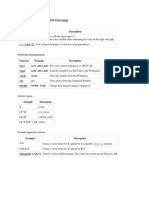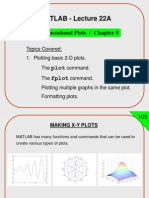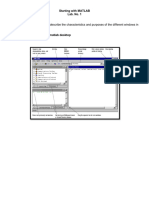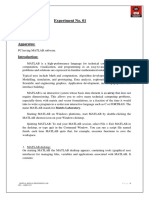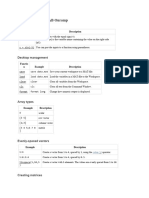0 ratings0% found this document useful (0 votes)
74 views2.017 Matlab Guide 1: A From The Workspace
2.017 Matlab Guide 1: A From The Workspace
Uploaded by
Dr. Ir. R. Didin Kusdian, MT.Matlab commands are case sensitive and variables can be upper or lowercase. help command provides descriptions of commands. Basic commands create vectors and matrices and perform element-wise operations. plot commands generate graphs with options to customize axes, labels, and styles. Loops and ode45 integrate systems over time. save and load commands archive and retrieve variable data in MAT-file and text formats.
Copyright:
Attribution Non-Commercial (BY-NC)
Available Formats
Download as PDF, TXT or read online from Scribd
2.017 Matlab Guide 1: A From The Workspace
2.017 Matlab Guide 1: A From The Workspace
Uploaded by
Dr. Ir. R. Didin Kusdian, MT.0 ratings0% found this document useful (0 votes)
74 views1 pageMatlab commands are case sensitive and variables can be upper or lowercase. help command provides descriptions of commands. Basic commands create vectors and matrices and perform element-wise operations. plot commands generate graphs with options to customize axes, labels, and styles. Loops and ode45 integrate systems over time. save and load commands archive and retrieve variable data in MAT-file and text formats.
Original Title
Matlab Guide1
Copyright
© Attribution Non-Commercial (BY-NC)
Available Formats
PDF, TXT or read online from Scribd
Share this document
Did you find this document useful?
Is this content inappropriate?
Matlab commands are case sensitive and variables can be upper or lowercase. help command provides descriptions of commands. Basic commands create vectors and matrices and perform element-wise operations. plot commands generate graphs with options to customize axes, labels, and styles. Loops and ode45 integrate systems over time. save and load commands archive and retrieve variable data in MAT-file and text formats.
Copyright:
Attribution Non-Commercial (BY-NC)
Available Formats
Download as PDF, TXT or read online from Scribd
Download as pdf or txt
0 ratings0% found this document useful (0 votes)
74 views1 page2.017 Matlab Guide 1: A From The Workspace
2.017 Matlab Guide 1: A From The Workspace
Uploaded by
Dr. Ir. R. Didin Kusdian, MT.Matlab commands are case sensitive and variables can be upper or lowercase. help command provides descriptions of commands. Basic commands create vectors and matrices and perform element-wise operations. plot commands generate graphs with options to customize axes, labels, and styles. Loops and ode45 integrate systems over time. save and load commands archive and retrieve variable data in MAT-file and text formats.
Copyright:
Attribution Non-Commercial (BY-NC)
Available Formats
Download as PDF, TXT or read online from Scribd
Download as pdf or txt
You are on page 1of 1
2.
017 Matlab Guide 1
Matlab commands are lowercase; variables can be either upper or lower; case sensitive.
help command gives a short description of command
a=[1 2] creates the vector a with one row and two columns, prints to screen
a=[1 2]; same, but does not print
a=[1;2]; creates the vector a with two rows, one column
This will overwrite any previous definition of a
global a; makes a visible to all programs that contain this line
clear a ; deletes variable a from the workspace
a=[1 2 ; 3 4]; creates a 2x2 matrix, first row is [1 2], second row is [3,4]
size(a); prints the size of a
b = a + 1; adds one to all elements of a
b = a + [1 2]; illegal: a is a 2x2 and you can’t add a 1x2 to it
b = a + [2 3 ; 4 5]; OK
t = 0:.1:10; creates the row vector [0 0.1 0.2 0.3 …. 9.9 10.0]
x = sqrt(t); creates x with the same size as t; point-wise square roots of t
x = input(‘What is your input: ‘);
asks the question and loads your response into x
disp(sprintf(‘The answer is %g.’ x(1))) ;
prints text to screen with the first element of x shown.
plot(x); plots x on the vert. axis, [1 2 3 4 … length(x)] on the horiz. axis
plot(t,x); plots x on the vert. axis, t on the horiz. axis
plot(t,x,t,x+1); plots two lines
plot(t,x,’o’); plots points with circles – no line
plot(t,x,’o-‘); plots points with circles and a line connecting them
subplot(114); will make the next plot in the 1,1 slot of a 2x2 “plot matrix”
subplot(‘Position’,[llx lly width height]);
will make the next plot in a screen position (0 to 1) defined by
lower left coordinates (llx,lly) and dimensions (width,height)
xlabel(‘text’); puts a label on the horizontal axis
text(x,y,’text’); puts the text at the location (x,y), measured on the axes as labeled
for i = 1:10; stuff ; end ; or i = 1 ; while i < 10; stuff ; i = i + 1 ; end ;
executes stuff ten times, with i taking a different value each time
[t,y] = ode45(‘function’,[t0 t1],y0);
uses 4th-order Runge-Kutta integration to propagate the system
defined by ‘function’ over the time window t0 to t1, and from
initial condition y0
save filename x t; saves the variables x and t (both names and data) to filename.mat
load filename; loads the file filename.mat, creating named variables in workspace
save filename.dat x –ascii
saves the data of x in text format in filename.dat
y = [x;y] ; save filename.dat y –ascii
saves data of y in text format in filename.dat – ARRAY only
load filename.dat loads data array from filename.dat; it appears as a variable called
filename in the workspace
You might also like
- Summary of MATLAB Onramp: Basic SyntaxDocument3 pagesSummary of MATLAB Onramp: Basic SyntaxGabriel GómezNo ratings yet
- Summary of MATLAB Onramp: Basic SyntaxDocument3 pagesSummary of MATLAB Onramp: Basic SyntaxSanthosh Kumar J100% (1)
- Matlab Intro11.12.08 SinaDocument26 pagesMatlab Intro11.12.08 SinaBernard KendaNo ratings yet
- DSP Practicle NO. 1 - 4Document10 pagesDSP Practicle NO. 1 - 4PRAFFULL JAINNo ratings yet
- Modeling and Simulation LabEXPT 2Document7 pagesModeling and Simulation LabEXPT 2Punit GuptaNo ratings yet
- 23MAT107 Calculus Lab2Document3 pages23MAT107 Calculus Lab2Abhinav pNo ratings yet
- Experiment 7: Multiple Plots in One Figure in MATLAB. Multiple PlotsDocument8 pagesExperiment 7: Multiple Plots in One Figure in MATLAB. Multiple PlotsArin SukhwalNo ratings yet
- MATLAB programs (1)Document26 pagesMATLAB programs (1)kelbesashibo429No ratings yet
- Matlab Cheat Sheet PDFDocument3 pagesMatlab Cheat Sheet PDFKarishmaNo ratings yet
- MatlabDocument3 pagesMatlabyannaingsoe999No ratings yet
- Summary of MATLAB Onramp Basic Syntax Example DescriptionDocument5 pagesSummary of MATLAB Onramp Basic Syntax Example Descriptionaditya bhandakkarNo ratings yet
- Summary of MATLAB OnrampDocument2 pagesSummary of MATLAB OnrampSourav DangNo ratings yet
- Summary of MATLAB CommandsDocument3 pagesSummary of MATLAB CommandsQuazar001No ratings yet
- MODULE 2.pptxDocument40 pagesMODULE 2.pptxbhagyaNo ratings yet
- Program 1 AimDocument23 pagesProgram 1 AimAshwani SachdevaNo ratings yet
- Matlab QuickRefDocument12 pagesMatlab QuickRefapple212aNo ratings yet
- ME18A - MATLAB Lecture NotesDocument49 pagesME18A - MATLAB Lecture NotesKillen B.No ratings yet
- Summary of MATLAB Onramp: Basic SyntaxDocument3 pagesSummary of MATLAB Onramp: Basic SyntaxBăh ŢăraneeNo ratings yet
- Summary of MATLAB OnrampDocument3 pagesSummary of MATLAB OnrampPuneet RathoreNo ratings yet
- Quick Matlab Reference: Note Command Syntax Is Case-Sensitive!Document7 pagesQuick Matlab Reference: Note Command Syntax Is Case-Sensitive!Mehmed UyarNo ratings yet
- Statistical Computing II-slide (1)Document279 pagesStatistical Computing II-slide (1)Gnrl Abera ArgataNo ratings yet
- DSP Matlab Practice FinalDocument39 pagesDSP Matlab Practice FinalTadesse MideksaNo ratings yet
- Plot Matlab PDFDocument4 pagesPlot Matlab PDFMuhammad Izzan H.SNo ratings yet
- Computer Applications in Engineering Design: Introductory LectureDocument49 pagesComputer Applications in Engineering Design: Introductory Lecturezain aiNo ratings yet
- T1 Making Plots Using MATLABDocument9 pagesT1 Making Plots Using MATLABsolid34No ratings yet
- Cpt115 - Mathematical Methods For Computer Science Lab 2: Universiti Sains Malaysia School of Computer SciencesDocument4 pagesCpt115 - Mathematical Methods For Computer Science Lab 2: Universiti Sains Malaysia School of Computer SciencesLily YeangNo ratings yet
- MATLAB - Lecture 22A: Two Dimensional Plots / Chapter 5Document32 pagesMATLAB - Lecture 22A: Two Dimensional Plots / Chapter 5Pankaj JadhavNo ratings yet
- Summary of MATLAB Onramp: Basic SyntaxDocument3 pagesSummary of MATLAB Onramp: Basic SyntaxLuis Benavides MahechaNo ratings yet
- Summary of MATLAB Onramp: Basic SyntaxDocument4 pagesSummary of MATLAB Onramp: Basic SyntaxSandeep NaikNo ratings yet
- MATLABDocument24 pagesMATLABAudrey CruzNo ratings yet
- Summary of MATLAB OnrampDocument3 pagesSummary of MATLAB OnrampAyush DoshiNo ratings yet
- Chapter 2Document20 pagesChapter 2kawibep229No ratings yet
- MATLAB-Fall 11-12 Introduction To MATLAB Part IDocument33 pagesMATLAB-Fall 11-12 Introduction To MATLAB Part IHusam QutteinaNo ratings yet
- Summary of MATLAB OnrampDocument3 pagesSummary of MATLAB Onrampshreeramtantry4No ratings yet
- FALLSEM2019-20 MAT1011 ELA VL2019201004380 Reference Material I 18-Oct-2019 EXP 5BDocument4 pagesFALLSEM2019-20 MAT1011 ELA VL2019201004380 Reference Material I 18-Oct-2019 EXP 5BdNo ratings yet
- MATLAB Onramp Quick ReferenceDocument4 pagesMATLAB Onramp Quick Referenceahmed.gameel.feNo ratings yet
- Introduction Part Ii: Graphics in MatlabDocument16 pagesIntroduction Part Ii: Graphics in MatlabMahreenNo ratings yet
- MATLAB Reference CardDocument2 pagesMATLAB Reference CardAkshar MeherNo ratings yet
- MATLAB Onramp Quick ReferenceDocument5 pagesMATLAB Onramp Quick Referencemukundapriya1981No ratings yet
- Octave Plot TutorialDocument4 pagesOctave Plot TutorialDahamNo ratings yet
- Ex MatlabDocument3 pagesEx MatlabBùi Thái HoàngNo ratings yet
- Lab # 1Document10 pagesLab # 1saadshahab622No ratings yet
- Experiment No. 01: Digital Signal Processing Lab - 1 UID: - 16BEC1037Document7 pagesExperiment No. 01: Digital Signal Processing Lab - 1 UID: - 16BEC1037sanchitNo ratings yet
- Summary of MATLAB OnrampDocument3 pagesSummary of MATLAB OnrampThe Dirty NapkinNo ratings yet
- BÁO CÁO THÍ NGHIỆM TÍN HIỆU HỆ THỐNG lap56Document12 pagesBÁO CÁO THÍ NGHIỆM TÍN HIỆU HỆ THỐNG lap56Văn Minh PhanNo ratings yet
- Divyansh Signal File.. (2) - CombinedDocument27 pagesDivyansh Signal File.. (2) - CombinedDivyansh YadavNo ratings yet
- تطبيقات الحاسوب Computer Application 6Document12 pagesتطبيقات الحاسوب Computer Application 6yousifNo ratings yet
- Summary of MATLAB OnrampDocument3 pagesSummary of MATLAB Onramp202118bt064No ratings yet
- MATLAB Training NotesDocument22 pagesMATLAB Training NotesbreannaNo ratings yet
- Summary of MATLAB OnrampDocument3 pagesSummary of MATLAB OnramppriyadarshiniNo ratings yet
- Summary of MATLAB OnrampDocument3 pagesSummary of MATLAB Onramppriyadarshini0% (1)
- Basic Matlab ExercisesDocument11 pagesBasic Matlab ExercisesAntony Real100% (1)
- Data TypesDocument27 pagesData TypesAugusto FerrariNo ratings yet
- FCS - Lab 1Document8 pagesFCS - Lab 1Najeeb RehmanNo ratings yet
- Labsheet_1Document4 pagesLabsheet_1kavi20053878No ratings yet
- R Short TutorialDocument5 pagesR Short TutorialPratiush TyagiNo ratings yet
- Getting Started With Matlab: The GUI WindowDocument4 pagesGetting Started With Matlab: The GUI WindowBenjamin LemešNo ratings yet
- Graphs with MATLAB (Taken from "MATLAB for Beginners: A Gentle Approach")From EverandGraphs with MATLAB (Taken from "MATLAB for Beginners: A Gentle Approach")Rating: 4 out of 5 stars4/5 (2)
- Reivision - Kalimantan River Transportation SustainabilityDocument10 pagesReivision - Kalimantan River Transportation SustainabilityDr. Ir. R. Didin Kusdian, MT.No ratings yet
- Transportation Planning Arround Conservation Forest Area at Supiori As A New Expanding Regency at Biak IslandDocument8 pagesTransportation Planning Arround Conservation Forest Area at Supiori As A New Expanding Regency at Biak IslandDr. Ir. R. Didin Kusdian, MT.No ratings yet
- Relatório SternDocument613 pagesRelatório SternANDI Agencia de Noticias do Direito da Infancia100% (2)
- Highway MeteorologyDocument216 pagesHighway MeteorologyaldokrenaNo ratings yet
- Investigasi Dan Aplikasi Dalam Analisis Power Flow Pada Sistem Dinamik Non Linier - Marine Transport - Yang - JianDocument1 pageInvestigasi Dan Aplikasi Dalam Analisis Power Flow Pada Sistem Dinamik Non Linier - Marine Transport - Yang - JianDr. Ir. R. Didin Kusdian, MT.No ratings yet
- Composite Pavement Virginia Tech 09 Cr2Document60 pagesComposite Pavement Virginia Tech 09 Cr2Dr. Ir. R. Didin Kusdian, MT.No ratings yet
- Interaksi Fluida-Struktur Pada Kapal Layar Balap Yacht - Marine Transport - Trimarch - DanieleiDocument1 pageInteraksi Fluida-Struktur Pada Kapal Layar Balap Yacht - Marine Transport - Trimarch - DanieleiDr. Ir. R. Didin Kusdian, MT.No ratings yet
- Disain Kapal Layar Balap Yach - Marine Transport - Scarponi - MatteoDocument1 pageDisain Kapal Layar Balap Yach - Marine Transport - Scarponi - MatteoDr. Ir. R. Didin Kusdian, MT.No ratings yet
- Beban Impak Hydro Pada Struktur Kapal - Marine Transport - Lee - JuneDocument1 pageBeban Impak Hydro Pada Struktur Kapal - Marine Transport - Lee - JuneDr. Ir. R. Didin Kusdian, MT.No ratings yet
- Interaksi Fluida-Struktur Pada Kapal Layar Balap Yacht - Marine Transport - Trimarch - DanieleiDocument1 pageInteraksi Fluida-Struktur Pada Kapal Layar Balap Yacht - Marine Transport - Trimarch - DanieleiDr. Ir. R. Didin Kusdian, MT.No ratings yet
- Pavement Design Manual Jan 09Document72 pagesPavement Design Manual Jan 09Dr. Ir. R. Didin Kusdian, MT.100% (2)
- Presentation File 11 TH Qir University of Indonesia 2009 Transport Planning Arround Conservation Forest Area at SupioriDocument31 pagesPresentation File 11 TH Qir University of Indonesia 2009 Transport Planning Arround Conservation Forest Area at SupioriDr. Ir. R. Didin Kusdian, MT.No ratings yet
- Source Coding: Source Encoder Channel Encoder Digital Source Source Entropy Symbols Binary Sequence ModulatorDocument18 pagesSource Coding: Source Encoder Channel Encoder Digital Source Source Entropy Symbols Binary Sequence ModulatortsegayNo ratings yet
- HW 1Document4 pagesHW 1M. Priyono Tri SulistyantoNo ratings yet
- Mobile Code SecurityDocument39 pagesMobile Code SecurityNarender KumarNo ratings yet
- Thesis Abstract Sample For Information TechnologyDocument6 pagesThesis Abstract Sample For Information Technologywendyrobertsonphoenix100% (2)
- 2011 Sasken Placement PaperDocument9 pages2011 Sasken Placement PapervenniiiiNo ratings yet
- (RE1.pl) : Regular Expression (Regex or Regexp or RE)Document5 pages(RE1.pl) : Regular Expression (Regex or Regexp or RE)sonal singhalNo ratings yet
- SWP391-AppDevProject - Design TemplateDocument5 pagesSWP391-AppDevProject - Design TemplateNguyen Phuong Nam (K14 HL)No ratings yet
- Mikrotik Mtcna Test 31 35Document5 pagesMikrotik Mtcna Test 31 35zaenal mustofaNo ratings yet
- Viterbi DecodingDocument4 pagesViterbi DecodingGaurav NavalNo ratings yet
- FX Server Release 14.x Catalog PageDocument10 pagesFX Server Release 14.x Catalog PageAlex QiNo ratings yet
- UntitledDocument202 pagesUntitledJuvenal Soncco HuisaNo ratings yet
- Failure Recovery in Distributed Systems PDFDocument2 pagesFailure Recovery in Distributed Systems PDFGregory0% (1)
- PSSE 34 Webinar Q ADocument7 pagesPSSE 34 Webinar Q Achandv7100% (1)
- Infographics CVDocument1 pageInfographics CVSubhash pragatheeswaranNo ratings yet
- VOACAP Propagation Planner Users ManualDocument21 pagesVOACAP Propagation Planner Users ManualBruno F4ILKNo ratings yet
- OMG - Product Lifecycle Management ServicesDocument399 pagesOMG - Product Lifecycle Management Servicesgweberpe@gmailcomNo ratings yet
- I2CDocument1 pageI2Cvincentho2kNo ratings yet
- IT Governance For SMEDocument37 pagesIT Governance For SMEAlan Mudary100% (1)
- Module 1 Notes 21cs62Document21 pagesModule 1 Notes 21cs62Varun NNo ratings yet
- FORM 4.1 Self Assesment Check ListDocument3 pagesFORM 4.1 Self Assesment Check ListNica ManlugonNo ratings yet
- GNS3 - Packet CaptureDocument3 pagesGNS3 - Packet Captureclu5t3rNo ratings yet
- Evaluation of OsDocument3 pagesEvaluation of Ossravs220% (1)
- Industry ProfileDocument5 pagesIndustry ProfileS.Abyisheik ReddyNo ratings yet
- Arbel G. Danduan: Career ObjectiveDocument3 pagesArbel G. Danduan: Career Objectivearbel danduanNo ratings yet
- Developing A Social Platform Using MERN StackDocument9 pagesDeveloping A Social Platform Using MERN StackĮt'š ŤąłháNo ratings yet
- VictorDocument81 pagesVictorShanmuk VarmaNo ratings yet
- Tuning FrmWEBDocument16 pagesTuning FrmWEBSupachai TaechapisitNo ratings yet
- XL Web SpecificationDocument4 pagesXL Web Specificationjohnney98No ratings yet
- Veda Murthy S #98, Model House Street, Basavanagudi, Bangalore Vedu - SH@Document3 pagesVeda Murthy S #98, Model House Street, Basavanagudi, Bangalore Vedu - SH@vedu_shNo ratings yet
- 1.UNIX Operating SystemDocument37 pages1.UNIX Operating SystemTharindu Achintha WadugeNo ratings yet
